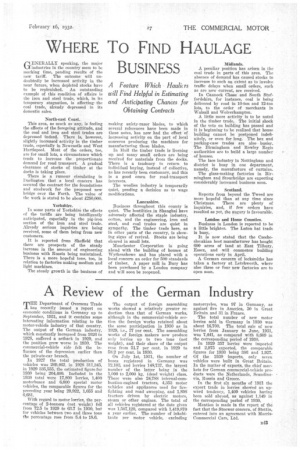A
Page 61

If you've noticed an error in this article please click here to report it so we can fix it.
Review of the German Industry
T'
■ Department of Overseas Trade has recently issued a report on economic conditions in Germany up to September, 1931, and it contains some interesting information relating to the motor-vehicle industry of that country. The output of the German industry, which constantly increased from 1926 to 1928, suffered a setback in 1929, and the position grew worse in 1930. The commercial-vehicle side felt the influence of the depression earlier than the private-car branch.
In 1927 the total production of vehicles was 209,462, in 1928 311,345, in 1929 335,555, the estimated figure for 1930 being 204,400. Included in the 1930 total were 17,800 lorries, 1,400 motorbuses and 6,000 special motor vehicles, the comparable figures for the preceding year being 29,922, 1,655. and 6,681.
With regard to motor lorries, the percentage of 2-tanners (net weight) fell from 72.5 in 1929 to 63.7 in 1930, but for vehicles between two and three tons the percentage rose from 5.4 to 18.6.
The output of foreign assembling works showed a relatively greater reduction than that of German works, although in the commercial-vehicle section the foreign works retained about the same participation in 1930 as in 1929, i.e., 37 per cent. The assembling works of foreign makers now produce only lorries up to two tons (net weight), and their share of the output rose from 51.7 per cent. in 1929 to 58.2 per cent. in 1930.
On July 1st, 1931, the number of buses registered in Germany was 12,103, and lorries 148,737, the largest number of the latter being in the 1,000 to 2,000 kg. (dead weight) class. There were also 24,788 internal-combustion-engined tractors, 4,353 motor vehicles and appliances used for firefighting and road sweeping, and 1,898 tractors driven by electric motors, steam or other engines. The total of all vehicles registered at the date given was 1,507,120, compared with 1,419,870 a year earlier. The number of inhabitants per motor vehicle, excluding
motorcycles, was 97 in Germany, as against five in America, 30 in Great Britain and 31 in France.
The total number of new motor lorries sold in Germany in 1930 was about 16,700. The total sale of new lorries from January to June, 1931, was 7,441, as compared with 8,609 in the corresponding period of 1930.
In 1929 357 lorries were imported and 2,975 exported, the comparable figures for 1930 being 386 and 1927., Of the 1030 imports, only seven vehicles were built in Great Britain. In the matter of exports, the chief tnar kets for German commercial-vehicle products were the Netherlands, Scandinavia, Russia and Greece.
in the first six months of 1.981 the export trade in lorries showed an upward tendency, 1,409 vehicles having been sold abroad, as against 1,149 in the corresponding period of 1930.
Mention is made in the report of the fact that the Stoewer concern, of Stettin, entered into an agreement with MorrisCommercial Cars, Ltd.




































































































